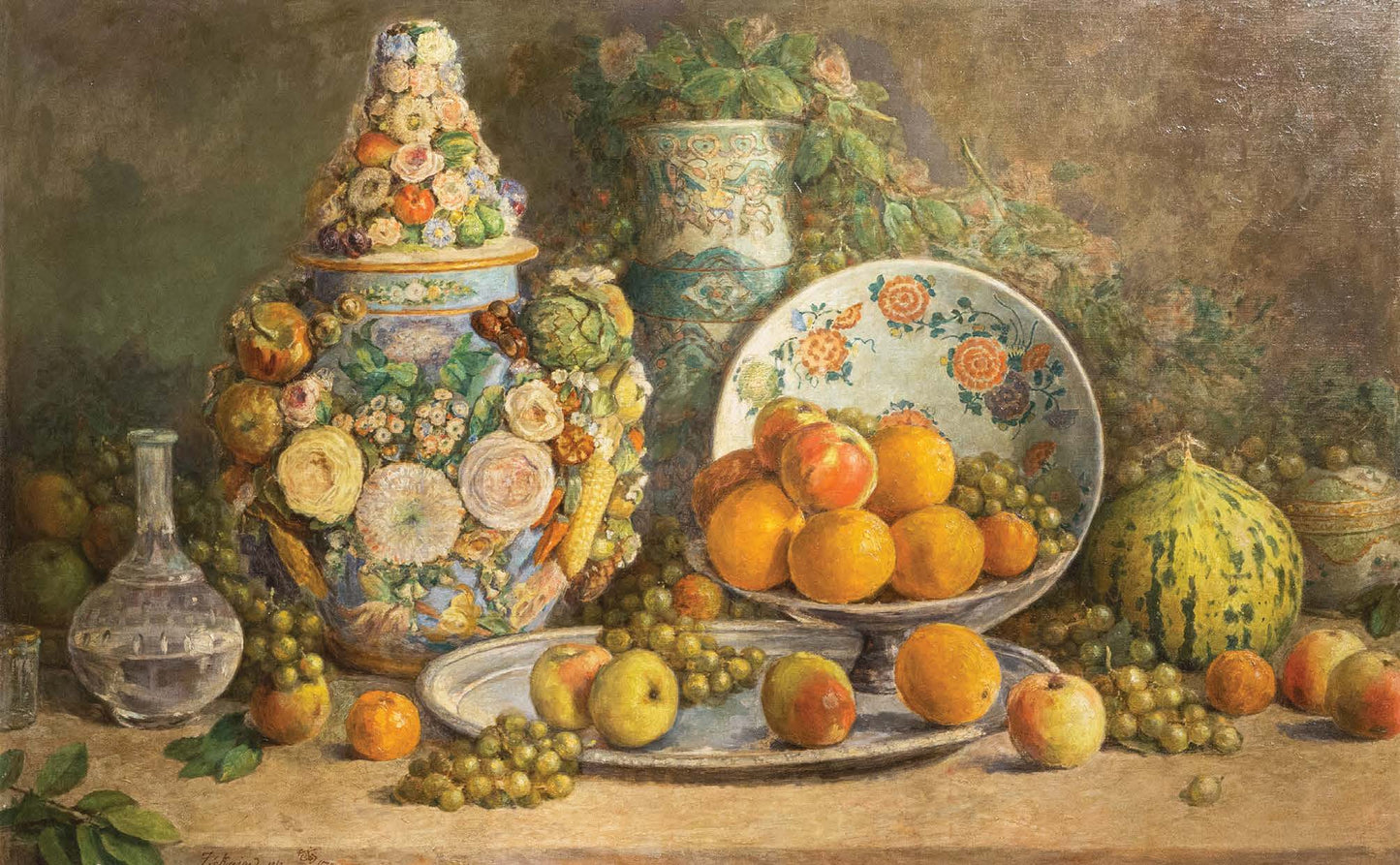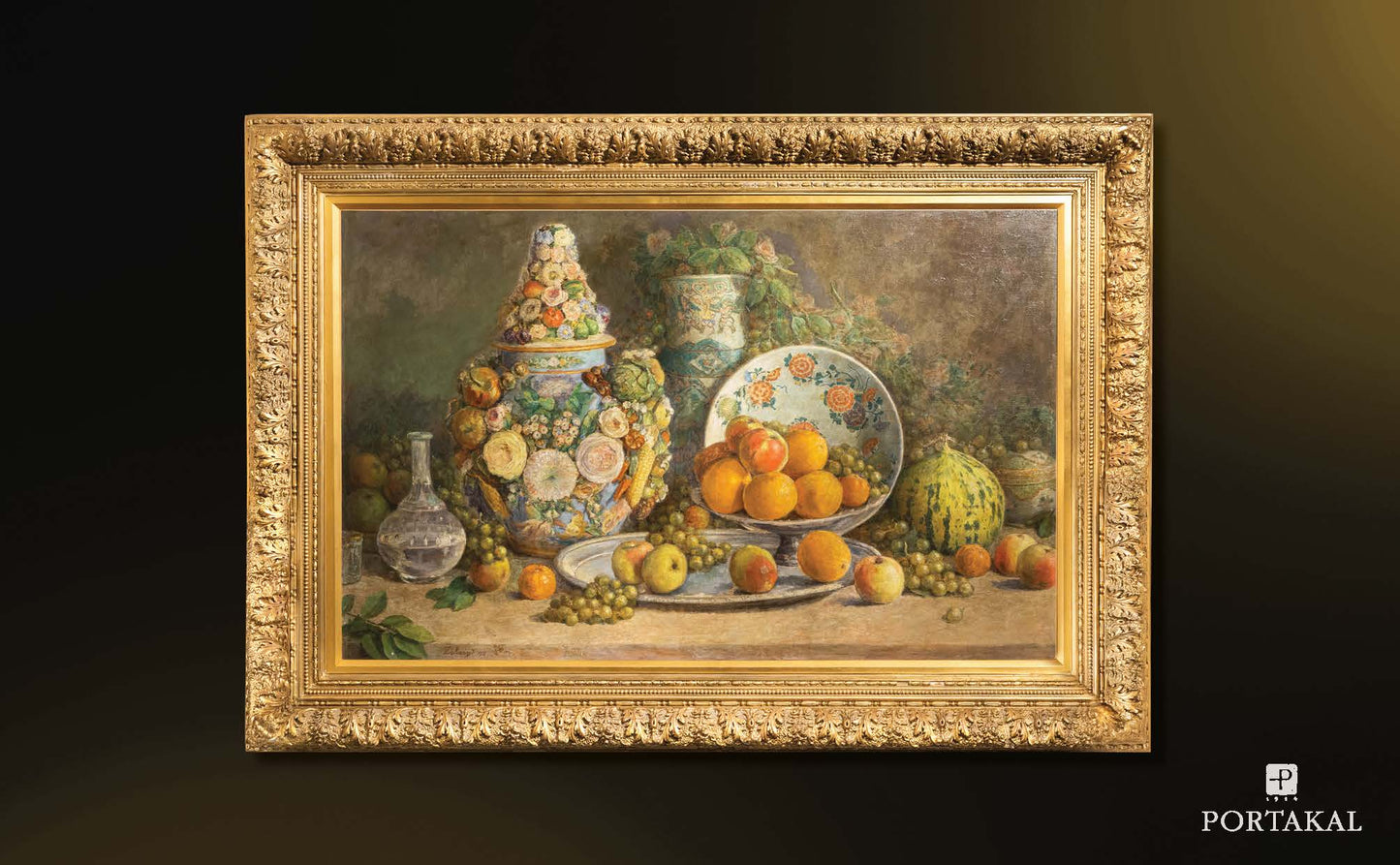HUSEYIN ZEKAI PASHA - STILL LIFE WITH FRUIT
HUSEYIN ZEKAI PASHA - STILL LIFE WITH FRUIT
HUSEYIN ZEKAI PASHA
1860-1919
Still Life with Fruits
Signed in Old Turkish and French
1326 (1910) and Latin letters, Oil on canvas, dated 1910
86 x 136 cm
Price is available upon request.
STILL LIFE WITH FRUIT
Still life painting is identified with the concepts of wealth, abundance and fertility.
It emerged in the 17th century. It was the economic golden age of the Netherlands.
17. century, still life art for also "full independence period happened. Black and sea in trade from the developments, both Subject both also request The elements of still life, which benefited from the meaning of "the luxury of life", became richer in proportion to the imported exotic products and the glittering objects of the wealthy bourgeoisie; especially the lush tables Subject took. Still Life directed towards Dutch painters, critics of the period negative to their attitudes despite, their wealth supported by the bourgeois class who wanted to see it on their walls. Willem Kalf, one of the important still life masters of the 17th century, examined “how light reflects and refracts on colored glass, the contrast and harmony between colors and textures”; Jan Vanmeer van Delft, on the other hand, depicted everyday bourgeois life with objects that you could almost touch if you reached out to the canvas. Even artists such as Rembrandt, who were generally interested in historical subjects, produced works in this genre from time to time.
The works of the Dutch masters of still life painting, Ambrosius Bosschaert, Willem Van AeIst, Jan Davidsz de Heem, Jan Huysum, Peter Boel, Maria Van Gosterwijck, Abraham Mignon, Jan Weenix, Hans Boujan, Davidsz de Hemm, Jan Van Der Hayden, Simon Verelst, Hubert Van Revesteyn, Adriaen Coorte, Jan Jansz Van Der Velde., Rachele Ruysch, Willem Kalf, Abraham Van Beyren, Gerrit Willemz Heda, Frans Snyders, were of interest to all painters who turned to this movement. While the art movement that began in Turkish painting at the end of the 19th century showed developments that were sensitive to the movements of European art, still life paintings also began to take their place within this integrity of meaning. As the art movements that began and developed directly at the request of the Ottoman Palace and the sultan began to spread around the palace, still lifes emerged as symbols of the abundance and fertility of the wealthy life of this environment. Still life painting. It spread to France and England in the 18th and 19th centuries through artists such as Watteau, Chardin, Greuze, Morland and Wilkie. Later, this understanding became widespread in new movements. For example, French Impressionists such as Manet, Claude Monet, Auguste Renoir also frequently used elements of this style in their paintings. Naturally, like European painters, Turkish painters primarily followed Dutch painters for still life paintings. However, Hüseyin Zekai Pasha's still life also carries values that overlap with the palette of Impressionist painters.
Created by in compositions The Ottomans for special made Hüseyin Zekai Pasha, who used porcelain, in this still life, Eser-i İstanbul, a lidded vase, a crystal water jug and glass, a Famille-verte vase, a Vienna sugar bowl, Far Eastern porcelain plate, silver tray And -footed with fruit expert One composition. Undoubtedly, it also bears traces of the Dutch still life painting tradition with flowers scattered throughout the space from porcelain vases distinguished from each other by their different forms and ornaments, vessels of various shapes, and fruits scattered among them. In another respect, it also displays identical qualities with the still life paintings spread among the Impressionist painters. When compared with the works of Frederic Bazille's "Flowers", Camille Pissarro's "Chrysanthemums In A Chinese Vase" and Auguste Renoir's "Mixed Flowers In An Earthenware Pot", it is clear that Hüseyin Zekai Pasha developed the characteristics of still life painting by studying the Impressionist artists, not limiting himself to Dutch painters.
Prof. Dr. Kiymet Giray
HUSEYIN ZEKAI PASHA 1860-1919
As the art movements that started and developed directly with the request of the Ottoman Palace and the sultan began to spread around the palace, still lifes emerged as symbols of the abundance and prosperity of the wealthy life of this environment. Still life painting. It spread to France and England in the 18th and 19th centuries through artists such as Watteau, Chardin, Greuze, Morland and Wilkie. Later, this understanding became widespread within new movements. For example, French Impressionists such as Manet, Claude Monet and Auguste Renoir also frequently used elements of this style in their paintings. Naturally, Turkish painters, like European painters, primarily followed Dutch painters for their still life paintings. However, Hüseyin Zekai Pasha's still life also carries values that overlap with the palette of Impressionist painters. Hüseyin Zekai Pasha, who used porcelains specially made for the Ottomans in the compositions he created, uses the Eser-i İstanbul lidded vase in this still life. Crystal water jug and glass, Famille-verte vase, Vienna sugar bowl, Far Eastern porcelain plate, silver tray and footed fruit bowl create a masterful composition. Undoubtedly, the flowers scattered around the space from porcelain vases, which are distinguished by their different forms and decorations, containers, between them scattered with fruits Holland still life picture It also bears the traces of the tradition. In another respect, it also shows identical qualities with the still life paintings that spread among the Impressionist painters. When compared to Frederic Bazille's "Flowers", Camille Pissarro's "Chrysanthemums In A Chinese Vase" and Auguste Renoir's "Mixed Flowers In An Earthenware Pot", Hüseyin Zekai Pasha's still life painting features only Dutch with painters annoyed without staying Impressionist artists in clearly shows that it has been developed by examining .
Share




